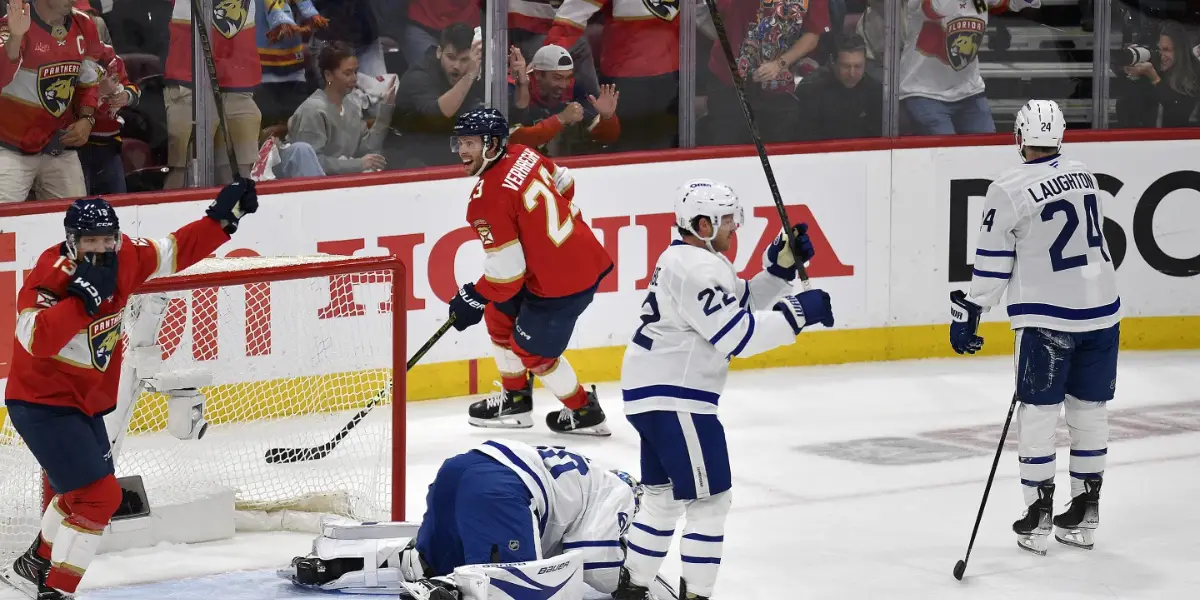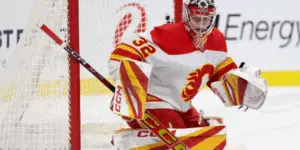
Another summer of celebration is underway as the Panthers have started their days with the Cup. While there is still one large looming question around Matthew Tkachuk’s status and the salary cap, I figured now was as good a time as any to start looking at what next season’s roster will look like. If you watched any game during the Playoffs, then you’re already familiar with them. Bill Zito did the seemingly impossible and kept his entire on-ice championship team together, apart from one starting defenseman in Nate Schmidt. Despite that, I wouldn’t expect the Panthers to be shoo-ins to win their division. These players have a lot of miles on their bodies, and the Olympics next year will likely have a good portion of the roster going. There’s also a lot of travel scheduled into the back half of the season for Florida next year. It’s going to be a rather challenging season for them, but last season proved that they only really care about winning enough games to make the playoffs. With all that said, this week I’m looking at Florida’s top line players.
Aleksander Barkov:
The first European Captain to win back-to-back Stanley Cups, Barkov leads his team by example with his defense-first mentality and hard work. He was second on the team in points to his linemate Reinhart and posted 71 points in 67 games, split between 20G & 51A. While that is down from last year’s 80 pts, he played six fewer games due to either injury or the Cats resting players at the end of the season. Sasha was also nearly a point per game during the playoffs, putting up 22 points (6G & 16A) for the second straight postseason in one fewer game. The personnel on the top line hasn’t changed from last year; Reinhart is still his locked-in right winger, with Verhaeghe and Rodrigues splitting time on the left wing. Barkov averaged the second-most TOI at 20:1,5 with time spent on the top power-play unit and short-handed. We may see a bit less of Barkov killing penalties next season with Florida able to retain Marchand for added depth and Luostarinen and Lundell stepping up to play bigger roles on the PK. Sasha had 9 PPGs, 19 PPAs, 1 SHG, & 3 SHA during the regular season. In the playoffs, he had 2 PPGs & 6 PPAs. Barkov also matched last season’s 4 game-winning goals. He tallied 149 SOG while shooting at a 13.4%. His shooting percentage is the highest it’s been since the ‘21-’22 season, where he shot at an 18.2%. In the playoffs, Barkov had 45 SOG and 20:29 TOI. Although he was only +/- +1 during the regular season, the team as a whole had a rough go of it when it came to the +/- compared to last season. The second line in particular had a really hard season. Once again, Barkov was the best Panther in the faceoff dot, posting a 56.5 FO% with 580 wins and 446 losses during the regular season. In the postseason, he only got better with a 58.3 FO%, winning 260 and losing 186. Sasha’s had some incredible highlight moments this year, including his 1v3 overtime shift against St. Louis in the regular season and his play in Game 5 of the ECF, where he outworked Orlav and got the puck to Verhaeghe, who scored the game-winner that sent the Panthers to their third straight Stanley Cup Final. He & his Finnish teammates got to share Finland with the rest of the team as they went overseas for the Global series and gave fans the iconic Florida Robe team arrivals. He got to captain Team Finland for the 4 Nations Faceoff, as well as being named to Team Finland for next year’s Olympics. Barkov also won his third Selke and his first King Clancy award for his work with Joe DiMaggio’s Children’s Hospital. Both trophies were presented to him by some of the children from Joe DiMaggio’s. Another year of hard work capped off with his second Stanley Cup and summer celebrations.
Samson Reinhart:
Clutch in the biggest game of the year with a four-goal performance, Reinhart was the team’s top point scorer in both the regular season and tied for 1st in the postseason. He put up 81 points (39G, 42A) and 23 pts (11G, 12A) respectively. For the first time in two seasons, Reinhart didn’t play a full 82 games with Florida opting to pull him for three games at the end of the year to help ensure he was healthy & ready for the playoffs. He did miss a couple of games in the ECF against Carolina due to a rather gnarly hit by Sebastian Aho, which turned out to be an MCL sprain. I don’t think it’s surprising that there was a dip in goals from Reinhart this season, as teams viewed him as a huge scoring threat and spent all season covering him hard on power plays. Even still, he put up 13 PPGs, 17 PPAs, 5 SHG, 1 SHA, and 4 game-winning goals in the regular season. His shooting percentage dropped closer to his average in recent years at 18.3% compared to last year’s 24.5%. Reinhart was down slightly in the faceoff dot with a 41.2 FO% and a 212-303 win/loss rate in the regular season. For the playoffs, he struggled but wasn’t one of the main faceoff takes with a 35.5 FO% and a 33-60 win/loss rate. He did, however, average the most TOI of all the forwards at 20:30 with 213 SOG in the regular season. That trend carried over into the postseason, where he averaged 21:30 TOI with 63 SOG and a 17.5 shooting percentage. The biggest season highlight came in the final game of the year, where he put up a four-goal performance to clinch the Panthers’ second straight Stanley Cup. It was his first career hat-trick in the playoffs and the first playoff hat-trick in franchise history. Samson was nominated for his first Selke Award in a rare feat where linemates were both named as finalists. His chemistry with Barkov is incredible, even when he doesn’t put up nearly 60 goals in a regular season. Reinhart was part of the Team Canada that won the 4 Nations tournament and has been named to Team Canada for the Olympics next year. Sam Reinhart is an elite mix of offensive scoring talent and a strong defensive game, making him a lethal partner to Barkov and Verhaeghe/Rodrigues.
Carter Verhaeghe:
Three Cups in his six years in the NHL, not too shabby for Verhaeghe. It was talked about all year long how rough a regular season Carter had. Whether it was bad luck, Cup hangover, or thinking he was washed, the numbers clearly stated that this was an outlier season for him. Despite all the struggles, he still put up 53 pts (20G, 33A) in 81 games, and during the playoffs, he had 23 pts (7G, 16A) in 23 games. The biggest tell of how off his regular season went was the shooting percentage. In the previous 5 seasons, he’d shot between 13.8% and 16.8%; this year, he shot at 8.3%. However, once the playoffs came around, Carter was back up to shooting at 13.5% comparable to the 13.9% from the 2024 playoffs, and tied his 7-goal mark from 2023, but put up a career-high 16 assists. The 23 points were tied for the most on the team and were a career-high for single postseason points. He tied his 4 PPGs from last year and had a career-high 3 PPAs. Verhaeghe was a clutch as ever with his fourth straight postseason of recording 3+ game-winning goals, including the one in Game 5 of the ECF, which sent Florida back to the Stanley Cup Final. There was more than enough discourse online about why Florida should trade Carter away despite the fact that the Cats had signed him to an eight-year extension at the top of the season, which kicks in next year. But HC Paul Maurice has said it best: Verhaeghe’s game excels in the high-pressure, high-intensity situations of the playoffs. Would it be great to see him regain some of his scoring touch next season during the regular season? Of course, especially if Tkachuk is going to be out a good portion of the season. Carter’s scoring ability is vital to the team’s success come May and June. But bad luck isn’t a crime, even if fans make it out to be, and his regular season was rife with shots being inches off from going in. Verhaeghe logged an average TOI of 17:52 and split his time on both the top and secondary PP units. Honestly, he looked fantastic on the second unit with Lundell, Marchand, Bennett, and Schmidt. He had 5 PPGs & 11 PPAs in the regular season with 242 SOG. He took a limited amount of faceoffs with a 36.4 FO% and 16-28 win/loss rate. He was at the exact same FO% for the playoffs at 36.4 with an 8-14 win/loss rate. Hopefully, this coming season, fans won’t be so quick to jump ship on one of Florida’s best playoff performers if he has another tough regular season. He shows up during the playoffs, and that’s when the Cats need him most. He might be one of the few Panthers who actually gets a break when the Olympics come around, but there’s also the possibility of him making the team when the full roster is announced. Team Canada chose to pass on him for the 4 Nations Tournament. Carter’s a clutch player who comes up in the biggest moments for Florida and has been vital to the team’s playoff success.
Coming Next Week: Florida’s Second Line Forwards

ITR 50: Atlantic Division Preview – Inside The Rink
Discover more from Inside The Rink
Subscribe to get the latest posts sent to your email.



